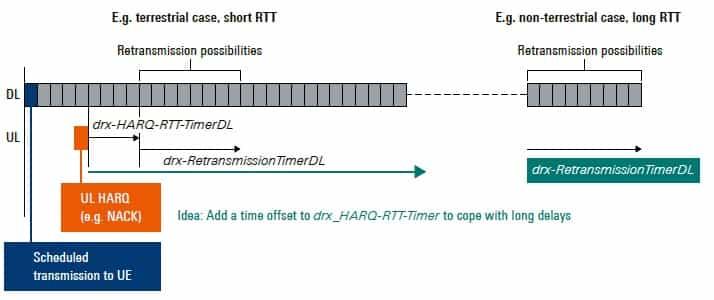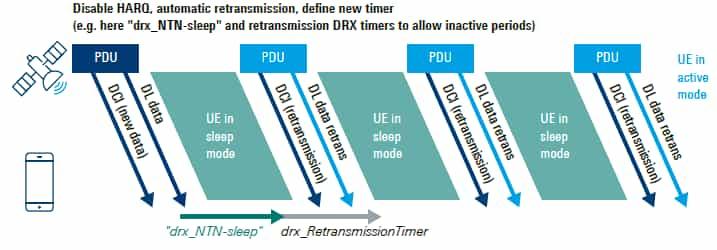DRX in 5G NTN: Power Saving for Satellite 5G
Advertisement
In this page we will understand implementation of Discontinuous Reception (DRX) and its essential power saving feature with respect to high latency NTN environment.
Function of DRx in NTN
The fundamental goal of DRX is power saving. It allows a UE to turn off its receiver for pre-configured periods of time (“sleep” cycle) and only wake up periodically to check for incoming data or pages (“ON” duration). This is especially critical for IoT-NTN devices, which are often battery powered and deployed in remote areas where frequent charging is not feasible. As per standard, IoT-NTN targets a very low activity factor (e.g., 1%), making efficient sleep modes essential.
Challenges of Standard DRX in an NTN Environment
A standard DRX implementation would fail in NTN due to several key challenges as follows.
- Satellite Visibility: A UE might enter a long DRX sleep cycle and, upon waking up, the LEO satellite it was connected to is no longer in view. The UE would then waste a significant amount of energy trying to search for a satellite that isn’t there in its view.
- HARQ Timing Mismatch: The timing for HARQ (error correction) is tightly coupled with DRX. A UE expects a potential retransmission within a specific time window. In NTN, the retransmission arrives much later due to the long RTT, long after the standard DRX timer would have put the UE back to sleep.
- Inefficiency with Blind Retransmissions: To ensure reliability when standard HARQ feedback is disabled, NTN can use “blind” (automatic) retransmissions. However, this forces the UE to stay awake for a prolonged period to receive these multiple transmissions, directly contradicting the power saving goal of DRX.
DRx Implementations and Solutions for 5G NTN
To overcome above mentioned challenges, several key adaptations have been planned/implemented in DRX mechanism for 5G NTN.
- Ephemeris Aware Cell Search : To solve the satellite visibility problem, the NTN implementation makes the DRX process “smarter” as follows.
- Function: Before waking up from DRX cycle to perform a cell search, the UE first consults its stored satellite ephemeris (orbital) data.
- Implementation: The UE can predict whether any satellite will be in a visible position at its scheduled wake-up time. If the prediction shows no satellite coverage, the UE will “suspend and defer the cell search process,” remaining in a low power state instead of wasting energy on a futile search.
- Adaptation of DRX Timers for HARQ:
To fix the timing mismatch with retransmissions, the core DRX timers related to HARQ are made flexible.
- drx-HARQ-RTT-Timer:
- Function: This timer tells the UE when to be active to receive a potential retransmission for specific HARQ process.
- NTN Implementation: The document explains that an optional offset is added to this timer. This effectively delays the UE’s wake-up moment, ensuring it listens for the retransmission at the correct, much later, time when it actually arrives over the satellite link.
 Image Courtesy : Rohde & Schwarz
Image Courtesy : Rohde & Schwarz
- Advanced DRX for Blind Retransmissions:
This is the most sophisticated adaptation, designed to balance reliability with power saving.
- The Problem: The standard drx-InactivityTimer keeps the UE awake after receiving data. To catch multiple blind retransmissions, this timer would need to be very long, which wastes power.
- NTN Solution : It has been planned to introduce new, NTN-specific timer (called drx_NTN-sleep).
- Function: This new timer would create short, dedicated sleep periods between scheduled blind retransmissions.
- Implementation: The network would schedule a series of automatic retransmissions. The UE would wake up for the first one, go into a short drx_NTN-sleep mode, wake up for the second one and so on. This allows the UE to receive all the necessary retransmissions for reliability without having to stay continuously awake for the entire duration, thus saving significant power.
 Image Courtesy : Rohde & Schwarz
Image Courtesy : Rohde & Schwarz
- Network operators must manage configuring DRX either as long DRx cycle or short DRx cycle
for NTN as per specific use case and balance is requires between battery life and data delivery timeliness.
- Long DRX Cycle: This provides the best power savings for the UE, as it can sleep for long periods. However, if the network has data ready to send, it must wait for the UE’s next wake up time. This adds significant latency to the data delivery.
- Short DRX Cycle: This reduces latency, as the UE wakes up more frequently. However, it dramatically increases power consumption.
Advertisement
 RF
RF

